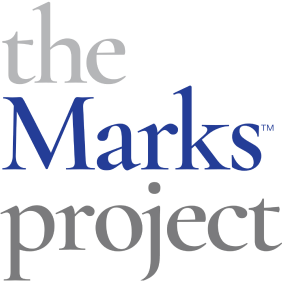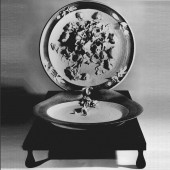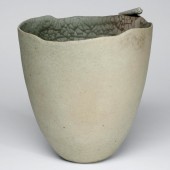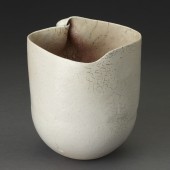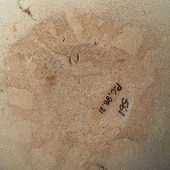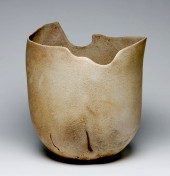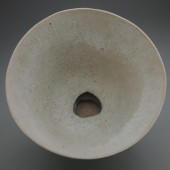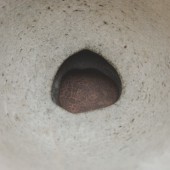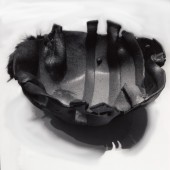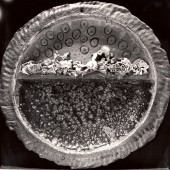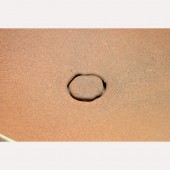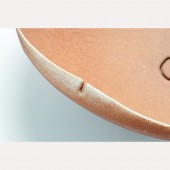![]() Printer version
Printer version
Richard DeVore
1933Born Toledo, Ohio
2006Died Fort Collins, Colorado
EDUCATION
1955BEd. University of Toledo, Toledo, Ohio
1957MFA Cranbrook Academy of Art, Bloomfield Hills, Michigan
WORK EXPERIENCE
1966Head of Ceramics Department, Cranbrook Academy of Art
1978-2004Faculty, Colorado State University, Fort Collins, Colorado
BIOGRAPHY
Richard DeVore concentrated on simple vessel forms; tall vases, shallow dishes and low bowls. The interior of these vessels was the primary focal point. His neo-primitive vessels had uneven or folded rims and, sometimes, distressed markings with a characteristic subtle skin-like surface. They echoed qualities of the pottery of the Anastasi and Mimbres Indians without a direct visual reference.
DeVore received his M.F.A. from Cranbrook where he studied with Maija Grotell. In 1966, she selected DeVore as her successor to head the ceramics department. During the 1960s he explored techniques and approaches to ceramics, including bright colors, lusters, and figurative sculpture. By late 1960s he began a body of work sharply focused on the vessel form for which he is known.
During his life, DeVore rejected the attempts to classify his work as ceramic sculpture, and insisted on it being called pottery. DeVore rejected embellishments and insisted on purity of form and surface. He used matte glazes to capture the subtle colors and textures of flesh, smooth stones or dried earth. Like Buzio and Delisle, DeVore used the vessel as a point of aesthetic departure from the traditional container, using only the essence of the form to create a unique sculptural ceramic work. DeVore reinvigorated the potter’s art by showing the potential of the vessel for expressing a personal contemporary aesthetic.
DeVore’s abstraction began with detailed drawings of each new object in which he worked out the volumetric relationships of the details to the finished work. He is known to have finished the rim last, adding folds or projections. DeVore’s work was important in establishing an understanding that clay could be used to create abstract art.
PUBLIC COLLECTIONS
Arizona State University Art Museum, Tempe, Arizona
Arkansas Art Center, Little Rock, Arkansas
Boymans van Beunigen Museum, Rotterdam, the Netherlands
Butler Institute of American Art, Youngstown, Ohio
Cleveland Museum of Art, Cleveland, Ohio
Contemporary Museum of Art, Honolulu, Hawaii
Cranbrook Academy of Art Museum, Bloomfield Hills, Michigan
Daum Museum of Contemporary Art, Sedalia, Missouri
Davis Museum at Wellesley College,, Wellesley, Massachusetts
Delaware Art Museum, Wilmington, Delaware
Denver Art Museum, Denver, Colorado
Detroit Institute of Art, Detroit, Missouri
Eastern Michigan University, Art Gallery, Ypsilanti, Michigan
Everson Museum of Art, Syracuse, New York, New York
Flint Institute of Arts, Flint Township, Michigan
Harrison Museum of Art, Utah State University, Logan, Utah
High Museum of Art, Atlanta, Georgia
J. Patrick Lannan Foundation, Los Angeles, California
John Michael Kohler Arts Center, Sheboygan, Wisconsin
Joslyn Art Museum, Omaha, Nebraska
Kestner Museum, Hanover, West Germany
Krannert Museum, University of Illinois, Champaign, Illinois
Kruithuis Museum, the Netherlands
Los Angeles County Museum of Art (LACMA), Los Angeles, California
Marietta College, Marietta, Ohio
Metropolitan Museum of Art, New York, New York
M.H. De Young Memorial Museum, San Francisco, California
Milwaukee Art Museum, Milwaukee, Wisconsin
Minneapolis Institute of Arts, Minneapolis, Minnesota
Mint Museum, Charlotte, North Carolina
Museum of Art, University of Iowa, Iowa City, Iowa
Museum of Arts and Design, New York, New York
Museum of Fine Art, Houston, Texas
National Collection of Contemporary Art, Paris, France
Nelson-Atkins Museum of Art, Kansas City, Missouri
Nelson Fine Arts Center, Arizona State University, Tempe, Arizona
Newark Museum, Newark, New Jersey
Philadelphia Museum of Art, Philadelphia, Pennsylvania
Philbrook Museum of Art, Tulsa, Oklahoma
Purdue University, West Lafayette, Indiana
Sheldon Memorial Art Gallery, University of Nebraska, Lincoln, Nebraska
Smithsonian American Art Museum, Renwick Gallery, Washington, D.C.
St. Louis Art Museum, St. Louis, Missouri
Tennessee State University, Nashville, Tennessee
University of Colorado Museum, Boulder, Colorado
University of Michigan Gallery, Ann Arbor, Michigan
University of Nebraska State Museum, Lincoln, Nebraska
Utah Museum of Fine Art, Salt Lake City, Utah
BIBLIOGRAPHY
Clark, Garth and Margie Hughto. A Century of Ceramics in the United States, 1878-1978. NY: E.P. Dutton, 1979.
Clark, Garth, and Cindy Strauss. Shifting Paradigms in Contemporary Ceramics: The Garth Clark & Mark Del Vecchio Collection. New Haven, CT: Yale University Press, 2012.
Dietz, Ulysses Grant. Great Pots Contemporary Ceramics from Function to Fantasy. Madison, WI: Guild Publishers, 2003.
Lauria, Jo. Color and Fire Defining Moments in Studio Ceramics, 1950-2000. New York, NY: Rizzoli International Publications, Inc., 2000.
Levin, Elaine. The History of American Ceramics: From Pipkins and Bean Pots to Contemporary Forms, 1607 to the present. New York, NY: Harry N. Abrams, Inc., 1988.
Lippard, Lucy, ed. Overlay: Contemporary Art and the Art of Prehistory. New York, NY: Pantheon Books, 1983.
Lynn, Martha Drexler. Clay Today, Contemporary Ceramists and Their Work A Catalogue of the Howard and Gwen Laurie Smits Collection at the Los Angeles County Art Museum. CA: Chronicle Books, 1990.
Manhart, Marcia, Tom Manhart, and Carol Haralson eds. The Eloquent Object the Evolution of American Art in Craft Media Since 1945. Tulsa, OK: The Philbrook Museum of Art, 1987.
McGowan, Robert, Janet Koplos, Emily Zilber, and Gregory Wittkop. Richard DeVore. Bloomfield Hills, MI: Cranbrook Art Museum, 2008.
Norland, Gerald. Richard DeVore, 1972-1982. Milwaukee, WI: Milwaukee Art Museum, 1983.
Perry, Barbara, ed. American Ceramics, The Collection of Everson Museum of Art. NY: Rizzoli, 1989.
Peterson, Susan. The Craft and Art Of Clay. London, UK: Calmann & King LTD, 2000.
CV or RESUME: Click Here to Download
Source: Elaine Levin Archive, University of Southern California
There are no known signed or marked pieces of DeVore’s work. A general statement cannot be made at this time, but two numbered examples are shown below. The first, Bowl #561, is on a piece in the collection of the Everson Museum of Art. According to the Everson Museum’s records this piece was made in 1988. The second, Bowl #548 pictured below in the collection of the Philadelphia Museum of Art is dated 1988 (we do not have a foot image of this piece).
Materials: Stoneware
Method: Thrown and Altered
Dimensions: 16 x 14 inches (40.6 x 35.6 cm)
Citation: "The Marks Project." Last modified August 4, 2023. http://www.themarksproject.org:443/marks/devore
